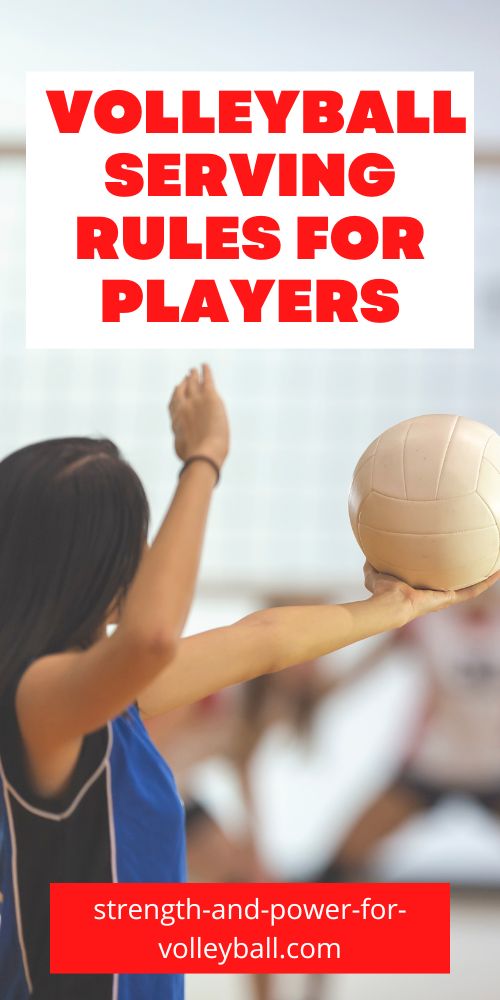Volleyball Serving Rules
Volleyball serving rules for executing the serve correctly. Use these tips to get an advantage over the competition.
Authorized to Serve
After checking to see both teams are ready to play, the referee will whistle and beckon the server to serve the ball.
The serve is act of putting the ball into play. This is done by the player in the right-back position.
A teams service will continue until that team commits a fault.
The first service of the set will be executed by the team that's determined at the coin toss. This is true for all deciding sets.
All other sets will started by the team that didn't serve in the previous set.
Service Order
Each team has a serving order. Each team must follow the serving order that's on the line up sheet.
When the serving team wins the rally, the player who served before, serves again.
When the receiving team wins the rally, the player that's in right-front rotates to right-back and is now the server.
Contact with Playing Surface
The server must have at least part of the feet in contact with the playing surface at the authorization for serve.
Toss or Release the Ball
The server must toss or release the ball out of the hand. The ball can't be hit while still in the hand. The ball must be tossed or released.
It's common for beginner volleyball players to make the mistake of hitting the ball out of the hand when first learning to serve the ball underhand. Technically, the ball needs to be released.
Only a single toss or release of the ball is allowed.
The serve must take place on the playable service.
For jump serves, the server must not touch the court or area outside the service zone when taking off the floor.
After contact, the server may land inside the court or land outside the service zone.
Depending on the organization and level of competition, the server may be allowed a 2nd toss for serve. For example, in usav 14 and under age groups, the serve has 5 seconds to contact the ball. After the ball is tossed or released, if the ball hits the floor untouched, the result is a tossing error and the referee will again authorize the server to execute the serve again.
After a Whistle for Serve, No Interruptions are Considered
Once the referee has whistled for serve, there will not be any interruptions allowed. This includes time-out, substitution, or line up check. This includes interruptions after a re-serve. The request for a line-up check is permitted when the result of a rally is a replay.
Screening - Volleyball Serving Rules
When considering screening, focus on the flight of the ball and whether or not the opponent can see the server.
The serving team must not prevent the opponent from seeing the ball.
The factor that a referee uses to weigh in on whether or not there's a screen are:
- positions of players relative to one another
- flight of the ball
- speed of the serve
- trajectory of the serve
For example, if players are close to one another, the ball is served quick and low and the ball passes over these players, the probability of a screen is high.
If players aren't close to one another, the ball is served higher, and the players are bending over in an effort to prevent a screen, the probability of a screen is lower.
Faults Made During the Serve
These are faults made by the serving team.
- The server violates the serving order
- The server doesn't execute the serve correctly. This includes tossing or releasing the ball or the ball hits an overhead obstruction.
- After the ball is correctly hit, there's a fault if the ball touches a player on the serving team, the ball fails to cross the net through the vertical crossing space (space between antennas), the ball touches an overhead obstruction, or the ball passes over a screen.
Serving and Positional Faults
If the server commits a fault at the moment the ball was contacted while the opponent is out of position, the serving fault is the fault that's sanctioned.
If the server executes the serve correctly while the opponent is out of position and the served ball results in going out of bounds, into the net, or over a screen, the positional fault is the fault that's sanctioned.
Tips for Smarter Serving
Here are some tips to get an advantage over your opponent by knowing the volleyball serving rules.
- Move along the endline to get an advantage. The service zone extends from sideline to sideline. Learn different ways to serve from different spots along the endline. Learn to serve the ball down the line. The easier ball to pass is the ball that's served cross-court. Serve the ball down the line to make it tougher for your opponent to pass.
- For jump serving, take off from behind the endline, but land inside the court. Using forward moment to create a more powerful serve.
- If you unsure if you are the correct server, have your captain or coach ask for a line up check before the referee whistles for the serve. If the referee has already whistled for the serve, someone needs to serve the ball. If you know who should be serving and you have enough time, quickly give the ball to the correct player and have them hustle back to serve the ball.
If you enjoyed these volleyball serving rules and would like to keep them close to you at any time, just save this pin to your Pinterest Volleyball Training Board.
